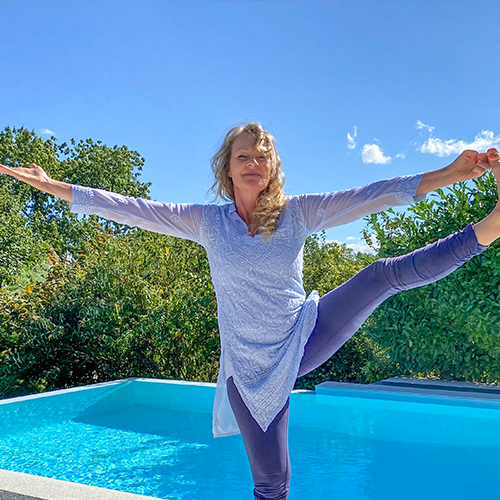Yoga. The definition of this sanskrit word is literally “union”. At its origin it is a Hindu spiritual and ascetic discipline, including breath control, simple meditation, and the adoption of specific bodily postures, and is widely practised for health and relaxation. It is a practice that has spread through many different cultures. Its popularity has grown through the past 50 years. But why now? Because, practical benefits of Yoga has never been more evident.
In our modern-day society we reward a frenetic style of living. Activity is honoured: constant moving ahead in one’s career, competition, creation of more wealth, looking for the best ways to live, being healthy, excel at everything… in opposition to this, yoga brings a person back to calm, to accepting oneself as they are today, to remove the constant longing to excel and just to “being” rather than “doing”.
It is not surprising that students are in search of this as we live in constant duality: light and dark, good and bad, sun and moon, highs and lows. Hatha, which is the word for the most common practice of yoga around the world, searches to unite this duality into one. So it is no surprise that so many people search for this practice of “being” which rests in direct opposite of the cultural pressures to excel and keep “doing”.

Practical Benefits of Yoga: Calming the Nervous System
So what are the practical benefits of yoga in today’s world? There are many, but let’s look at one of the most effective and powerful: Calming the nervous system.
When you step out of a yoga class, no doubt you feel better from head to toe. Your muscles feel more relaxed, you may feel stronger, and then there’s the mental clarity. But what’s really going on in the nervous system?
“We know that accumulating evidence shows yoga is good for your body, health and mind. Yoga has been used in the treatment of anxiety conditions, depression, insomnia, eating disorders, and others,” says Jonathan Greenberg, PhD, a postdoctoral research fellow in the department of psychiatry at Massachusetts General Hospital and Harvard Medical School. Even when applied to large populations, like those in prison, it increases inmates’ sense of wellbeing and self-control.
The deep breathing and meditation may work on what’s called the HPA axis (or hypothalamic-pituitary-adrenal axis), which controls your sympathetic nervous system (the fight or flight response) as well as the parasympathetic nervous system (the rest and digest response). Yoga may reduce the SNS and increase the PNS, resulting in a reduction in heart rate and blood pressure, says Greenberg. Your brain takes cues from your body (and vice versa, of course). So when your body is calming down, your brain gets the message that all is well.
But you don’t want an activated PNS all the time – you would be to relaxed to react to any serious situation. You want to be more like a calm and collected person who is also alert and energetic. That involves a balance between your SNS and PNS. Yoga can teach you to use your SNS when you need it for clarity, alertness and focus without going into the fight or flight response – being calm but alert.
Yoga Helps Your Brain to Rejuvenate
In addition to the nervous systems, there is mounting evidence that yoga turns back the years on your brain, too. In one 2017 study published in the journal International Pschogeriatrics, older adults (over age 55) with mild cognitive impairment spent 12 weeks either practicing Kundalini yoga or memory training. While both groups’ memory improved, the yoga group saw a boost in executive functioning. Also emotional resilience, possibly due to the chanting in this yoga that strengthens verbal and visual skills, the researchers report.
Additional observational research on mindfulness and meditation sheds light on how classes may actually influence your brain structure, says Greenberg. (Research on yoga alone is limited, but you can make some inferences by looking at meditation studies, he notes.) Studies looking at how the brain changes before and after meditation found that brain structures involved in awareness, attention and self-related thinking changed in structure and increased in volume. Plus, there’s your memory. “After eight weeks of meditation training, research found that the hippocampus, which is involved in learning and memory, developed more grey matter density…”.

Yoga Makes You Think Better
Finally, there is anecdotal evidence that yogis tend to have a more relaxed reaction to problems and disturbing events. As Greenberg points out, those who meditate have a larger right insula (the portion of the brain that involves body awareness). That’s a good thing. “It’s important when you encounter a stressful situation. Knowing your reaction to stress can help you identify the emotion, nip it in the bud and prevent it from escalating,” he says. Your amygalda — the reptilian part of your brain that reacts to fear — may also decrease its reactivity response to stress.
OK, this is all great news. But how much and how often should we practice to get practical benefits of yoga? There isn’t an agreement among researchers that there’s an ideal amount to practice yoga. Forthcoming research that Greenberg is a part of suggests you need 40 minutes a day for significant stress reduction. Of course, a single session can buffer your stress response. However, there’s the question about how long that lasts for, and that’s not clear yet.

Amy Wheeler, PhD, serves on the board of directors for the International Association of Yoga Therapists. She is a professor at California State University in San Bernardino, suggests yoga twice a week. “I’ve been teaching students yoga for 21 years. Every quarter, I see that in just 10 weeks, there’s a noticeable decline in anxiety and stress,” she says. Three times per week is better, but start with the goal of two.
“We can talk about anxiety, depression and blood pressure lowering in yoga, all of those are proven. But the biggest thing we see that results from yoga is that your quality of life will change for the better.” she says.
Ref: CNBC report: Aug. 22, 2017, 9:25 PM CEST / Updated June 21, 2018, 11:02 PM CEST, By Jessica Migala
AUTHOR: ANNE

Hi! I am Anne. I am a fitness and wellness coach with over 25 years of experience in the Swiss Romande area. I am a Yoga Alliance Certified Teacher for 500 hours and for Training Teachers in Continuing Education. I am passionate about helping individuals reach their highest potential and dedicated to attaining and maintaining fulfilment and happiness in every aspect of life.


